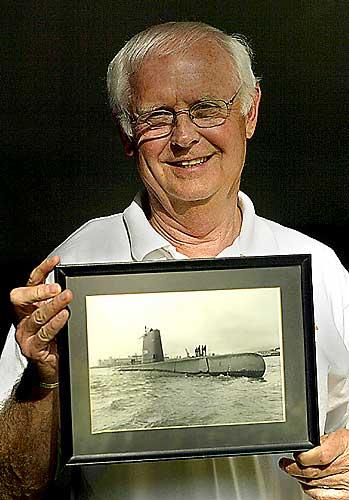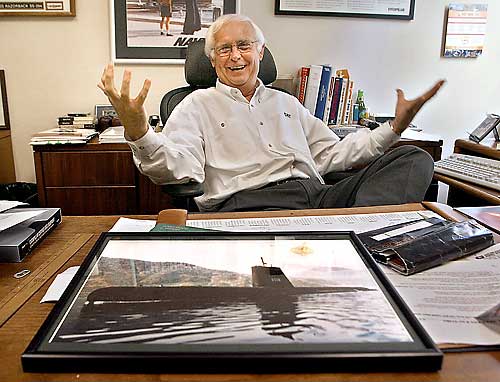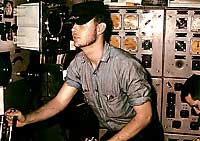|
|
|
|
|
|
|
SEATTLE POST-INTELLIGENCER NORTH LITTLE ROCK, Ark. -- Thousands of people gathered Sunday on the banks of the Arkansas River to welcome a historic U.S. submarine to its new home at the site of an inland maritime museum. The USS Razorback is believed to be the world's longest-serving submarine, spending 31 years with the Turkish navy after the Navy decommissioned and sold the vessel in 1970. City officials in North Little Rock bought the submarine from Turkey for $1 plus shipping costs to make it the centerpiece of the 10.5 million Arkansas Inland Maritime Museum. About 7,500 cheering well-wishers welcomed the vessel, waving flags and listening to bands and speeches. As the submarine approached a barge where dozens of dignitaries waited, her top deck was lined with Navy veterans. Mayor Patrick Hays rode atop the submarine's "sail," or conning tower, along with U.S. Sen. Mark Pryor and his four children. "For years to come, the people of central Arkansas, and, indeed, of the country, will be able to share a portion of the unbelievable history that's woven into the hull of this vessel," said Maj. Gen. Don Morrow, adjutant general of the Arkansas National Guard. Capt. Alaettin Sevim of the Turkish navy, the last commander of the vessel under that nation's flag, received a hearty round of applause, as did the submarine's last two U.S. Navy commanders - retired Capt. Joseph T. Talbert Jr. and retired Capt. Ken Brown. But the biggest applause by far went to Lawrence B. Crann, who served aboard the Razorback as a lieutenant commander in the closing days of World War II, stepping down in 1946 as her executive officer, or second in command. He saluted the American flag at the ship's stern before stepping slowly down the gangway. The 312-foot Razorback departed from Istanbul on May 5, towed by an oceangoing tugboat. It was launched in 1944 and was one of 12 U.S. submarines present at the official Japanese surrender that ended World War II. It was awarded five battle stars during World War II and four during the Vietnam War. The submarine's name is unrelated to the Razorback mascot of the University of Arkansas. The vessel was named for a species of whale. --- |
|
|
Deep longing spurs
By Warren Cornwall
Seattle Times Eastside bureau
Just a year ago, Bob Opple figured memories and scrap metal were the
only things left of the USS Razorback.
The World War II-era submarine on which he came of age in the early '60s
had long been obsolete. Similar boats had, as sailors say, been turned
into razor blades.
Now the 63-year-old is making plans to help sail the sub from Turkey to
the United States.
The story sounds like Disney fiction: a group of aging veterans set out
to rescue their beloved boat from the scrap heap by striking a deal to
buy it from the Turkish navy and sail it home, where it will come to
rest as a maritime museum.
"We're just a bunch of old submarine vets who have found ourselves a
toy," said the white-haired Bellevue man. "I can't think of anything
more fun."
It was November 2001 when a visiting salesman noticed photos of the
Razorback on Opple's Tukwila office wall. The salesman had stepped
aboard the boat a year-and-a-half earlier, he told Opple. It was called
the Murat Reis, and it was in the Turkish navy.
The news reignited an ember lit when, as a 19-year-old, Opple first went
to sea in the Razorback.
Opple phoned two former shipmates and told them the submarine was still
afloat. They discussed a final visit to the boat before its demolition.
But talk of a farewell trip turned into a rescue mission.
What if they could somehow buy the submarine and return it to the United
States?
"Even as I think of it today, I've got to tell you it sounds like a
fantastic idea," said Maurice Barksdale, a onetime cook on the Razorback
and now a 63-year-old commercial real-estate consultant in Fort Worth,
Texas.
They wanted to save more than a metal tube with a turret. It's a piece
of history that left an indelible mark on their lives.
The veterans entered the Navy as cocksure young men. They came out of
the Razorback as comrades disciplined by the pressure of weeks
underwater and Cold War cat-and-mouse games with Soviet warships.
"There's a bond that's kind of hard to explain that develops between
guys that serve on a submarine," Barksdale said. "You literally depended
on each and every person on board for your life."
Cold warriors on diesel submarines spent days underwater in cramped
compartments, without showers, living with the smell of diesel fumes and
fear of getting caught. Secrecy kept them from discussing their missions
even with wives and children.
"These guys gave up everything," said Sherry Sontag, co-author of "Blind
Man's Bluff," a history of Cold War submarine espionage.
After the Razorback, their lives diverged. Opple became a marketer at NC
Machinery, a heavy-equipment dealer, and settled in Bellevue. Barksdale
returned to his home state of Texas and became active in the Republican
Party. He eventually earned an appointment as an assistant secretary in
the Reagan administration's Department of Housing and Urban Development.
Max Bassett, now 67, remained in the Navy, moving on to other submarines
before retiring to Florida.
The submarine, meanwhile, remained in the U.S. Navy until it was
transferred to the Turkish navy in 1970.
But the years on the Razorback stayed with the three men. They framed
photographs, joined veterans groups and corresponded with shipmates.
None, however, imagined getting the boat back.
Until Opple called.
Opple, who made a career in marketing and whose sonorous voice and
lively manner earned him a third place in the World Championship of
Public Speaking, turned his skills to getting the Razorback.
They phoned a group of Arkansas submarine veterans, thinking a boat of
that name belonged in the Razorback state.
The veterans lobbied Mayor Patrick Hays of North Little Rock, suggesting
the boat as the centerpiece of a maritime museum on the banks of the
Arkansas River. The mayor and the veterans in turn reached out to other
officials and started talking with the U.S. State Department and the
Turkish government.
"It was nine months of up and down," Opple said.
Finally, in September, Hays went to Turkey for meetings with government
officials. There, Hays said, they were told the Turkish government would
give the submarine to North Little Rock.
"They have told us they are going to give it to us. They are not going
to charge us. But we don't have a bill of sale," Hays said, pausing for
a moment. "I don't know if there ever is a bill of sale for a
submarine."
Capt. Alaettin Sevim, a naval attaché with the Turkish embassy in
Washington, D.C., confirmed that his government had agreed in principle
to turn over the submarine to North Little Rock.
Weeks after the first visit to Turkey, Opple and Bassett stood at a
naval dock in Golcuk, Turkey, looking at the Razorback.
"It was like meeting the love of my life who I haven't seen in 40
years," Opple said.
They climbed aboard and descended into the forward torpedo room. When
they reached the maneuvering room, Opple put his hands on the levers he
had stood beside for hours as a young man, controlling the boat's speed.
Decades later, he could recite the steps to prepare for a dive.
"Is that not a guy who looks happy?" Opple said as he showed a
photograph of him at the controls in Turkey, beaming.
Now he sits in his office and considers how they will get a 58-year-old
submarine from Turkey to Arkansas.
The crew, Opple said, would include a group of current sailors and
submarine veterans, along for the final ride of their lives. New groups
of veterans could join and leave as the submarine stops at ports along
the way, he said.
"We've got several hundred people that want to go," said Opple, who
wants to make the full trip.
First, group members need to figure out how to pay for it. An initial
estimate put repairs at $1.4 million to make it seaworthy, said Greg
Zonner, commander of the submarine veterans group in North Little Rock.
They wanted to know how much it would cost to fix if they didn't need to
dive the boat, and simply sailed it on the surface. That, he said, could
cost $500,000.
The cheapest option, and the least romantic, would be to hitch it to
another boat and tow it across the Atlantic.
Donations could finance the trip, either from people who would pay to
sail on it or from supporters eager to see the submarine return, Opple
said. Buoyed by their achievements, he seemed unfazed by the remaining
hurdles.
"We're going to have to raise some money," he said. "But what's a
million dollars?"
Warren Cornwall: 206-464-2311 or
wcornwall@seattletimes.com.
|
|
|
Nostalgic sailor saves sub
Full story:
http://archives.seattletimes.nwsource.com/cgi-bin/texis.cgi/web/vortex/display?slug=sub07e&date=20040507
By Warren Cornwall
Seattle Times Eastside bureau
More than four decades
ago, Bellevue resident Bob Opple went to sea on the USS Razorback. He
was a 19-year-old kid on a submarine enlisted in the secretive
underwater battlefield of the Cold War.
Wednesday he pulled out of an Istanbul dock with the Razorback once
again, a 64-year-old man realizing a nostalgic dream to save the ship
from the scrap yard.
"I'm like a kid in a candy store," he said last week as he prepared to
leave his suburban home and rejoin the boat in Turkey.
Opple hatched the idea of bringing back the Razorback in late 2001,
shortly after he discovered the World War II-era diesel-powered
submarine had been turned over to the Turkish navy and was being retired
from service.
Since then, the upbeat heavy-equipment salesman has turned his skills to
the submarine, enlisting a cast of boosters that includes Navy veterans,
leaders of the Arkansas town of North Little Rock and Turkish
politicians.
"Bob Opple was, in my estimation, the lead salesman," said Steve
Nawojczyk, project manager of North Little Rock's plan to make the
submarine a cornerstone of a maritime museum on the Arkansas River. "I
pegged him right away as the guy who had about 500 pounds of enthusiasm
in about a 170-pound body. It's obvious that he's married to that boat."
Now the submarine is being towed from Turkey to North Little Rock, and
Opple is along for the first leg of the ride, to Gibraltar, near the
meeting point of the Mediterranean Sea and the Atlantic Ocean. He is
riding in the tugboat, though he plans to spend at least one night
sleeping on the submarine.
Opple had moments of doubt in the years leading up to Wednesday.
"It was just a dream," he said of the initial idea, which he hatched
while talking with a few Navy buddies after learning the submarine was
still afloat.
Rescuing the boat would take more than $1 million and approval from
Congress, the State Department, the Navy and the Turkish government.
Also, where do you put a 311-foot-long submarine?
Opple enlisted the help of Navy veterans in Arkansas, whose trademark
animal is a wild hog called a razorback. That led to the city of North
Little Rock, which was looking for a centerpiece for plans to develop
its waterfront.
City officials embraced the idea of incorporating the submarine into a
proposed $15 million Arkansas Inland Maritime Museum, and took the lead
in navigating the political and military waters involved in getting a
military vessel from a foreign country.
Opple's work also captured the imagination of submarine veterans in the
Puget Sound area.
The Razorback was the first boat Shane Foraker served on. Now a retired
Navy commander living in Poulsbo, he spent roughly $5,000 printing color
brochures about the Razorback and mailing them around the country.
Foraker recalled life in the submarine as cramped, smelly and brutally
hot at times. It also helped forge him into the man he became. The
chance to see it again was irresistible.
"Did you ever forget your first love?" he asked.
The deal appeared near completion in 2002 when the march toward war in
Iraq upset U.S.-Turkish relations. That put a hold on efforts to have
the Turkish government give the submarine to North Little Rock.
Opple's wife, Chris, said he would sometimes come home discouraged and
uncertain.
"He's said off and on, 'You know, this might be stupid.' And I said, 'I
don't think so.' "
Finally, in March of this year, the Turkish government turned the
submarine over to the city. A Little Rock-based investment company
donated $400,000 to the project, and a coalition of veterans groups
promised $1 million over five years.
There is now more than the $2 million needed for the museum's first
phase, said Rose Crane, who heads the fund-raising effort. That will
include the submarine, the USS Hoga — a tugboat that survived the
Japanese attack on Pearl Harbor in 1941 — and two barges that will house
the museum's visitor center. It should be open to visitors by the late
summer or early fall, Nawojczyk said.
Opple's only disappointment is that they can't sail the submarine back
to the United States under its own power. It was too expensive to make
needed repairs on the boat. Instead, it will be towed across the
Atlantic Ocean, up the Mississippi River and then up the Arkansas River.
The Razorback is scheduled to arrive in late June.
Then Opple wants to turn his attention to acquiring one of the few other
diesel submarines still in existence. That one, he said, should come to
Puget Sound.
Warren Cornwall: 206-464-2311 or
wcornwall@seattletimes.com
|
|


